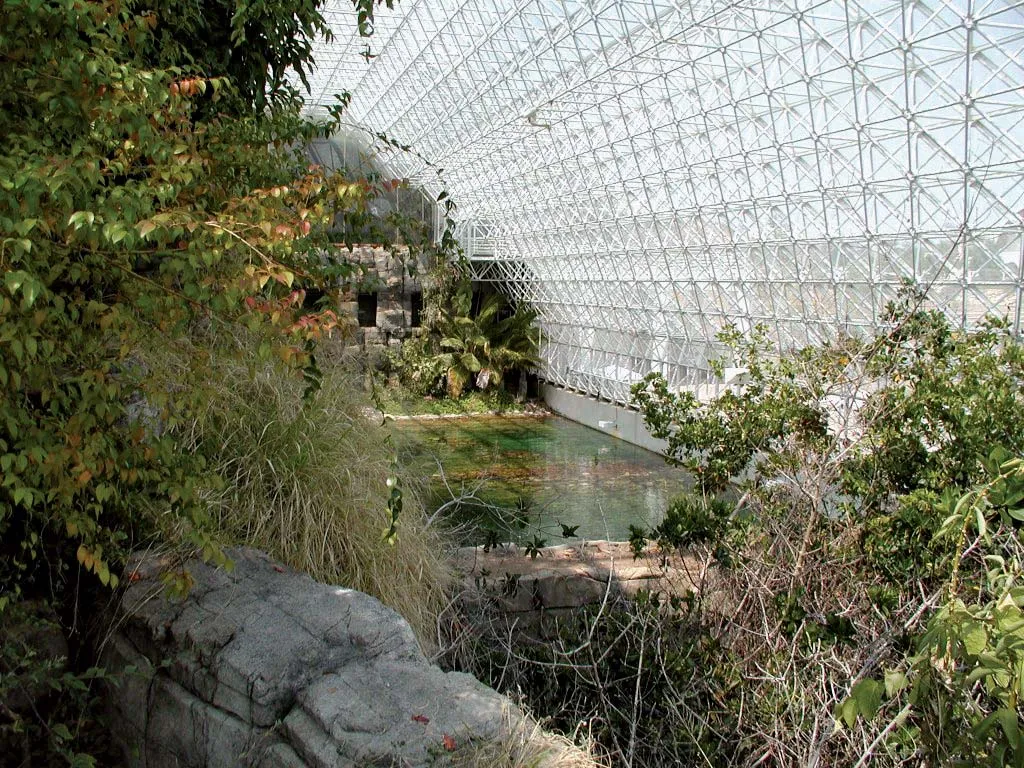MaCAD 23/24 // ACESD Theory
Existing State of Urban Design
In order to understand how to strive for successful ecological design practices, designers must first understand the problems that currently exist in the process of urban design. The current state of design tends to create distinct enclosures between both natural ecosystems and humans, with the availability of natural habitats shrinking exponentially.

These distinct zones have unintended consequences for people, where food, resources and recreation get further from the areas for living. A result is increased emissions, urban heat and pollution coupled with fewer carbon sinks, biodiversity loss and worse health outcomes. The combination of separating humans from their surrounding environments and their food production is ultimately causing Inflexible Urban Hardscapes – like Mexico City shown above – that are overpopulated and polluted. As urban hardscapes take over, the systems humans depend on – food, water and clean air – begin to irreversibly collapse.
Recent Attempts
Attempts in modern history to weave together natural and built environments have come with mixed results. Amidst the sand, rock and cacti of Arizona, the Biosphere 2 was an experiment in sealed ecosystems. Theoretically a closed-loop system in which humans lived at the source of their food and fresh air provided by plants, the project encountered significant logistical issues. It was revealed that although the system was supposed to be sealed, vitamins and food were sent to the inhabitants of Biosphere 2, as were mouse traps and oxygen tanks when an oxygen-consuming bacteria reduced oxygen to dangerous levels. Perhaps these technical issues could be resolved with yet more sensitive technology, but a sealed environment has 2 major issues: Everything must be perfectly calibrated and predicted & It does not interact with the local ecosystem.

A New Design Shift
Fortunately, a new paradigm is starting to emerge in projects, and the aim is to generate the best possible outcomes for ecologically designed buildings and cities. In order to achieve this, society and nature need to be considered as one complex and interconnected system that work together. This system should include the appropriate Ecological Design Components depending on project scope and surrounding environment. Every location and project introduces and reveals new sets of interactions which add to local knowledge libraries to benefit the overall design and serve as precedents for future interventions. It is essential that these local libraries are informed by the vernacular architecture and indigenous practices specific to the projects context.


In order for ecological design to be successful, designers must universally consider things like plant life, water cycles, indigenous knowledge, people, animals and our atmosphere as essential elements of a thriving planet, city and building. Along with literally incorporating nature into our projects, ecological design means learning from and using the principles of natural systems such as circular lifecycle processes. When applying the appropriate ecological design components based on the climate and surrounding context, designers will be stocked with the correct tools to create an ecosystem that incorporates existing natural systems as well as human made ones.
Reversing Ecosystem Degradation – Visual Manifesto

References
Brilio. (2016, October 11). Subak: Ancient Secret Behind Balinese Postcard-Worthy Rice Fields. Brilio. https://en.brilio.net/wow/subak-ancient-secret-behind-balinese-postcard-worthy-rice-fields-161011k.html
Indigenous people created the Amazon dark earth. Science News. https://www.sciencenews.org/article/indigenous-people-created-amazon-dark-earth
Learning for Sustainability. (n.d.). Systemic Design – An Introduction. Learning for Sustainability. https://learningforsustainability.net/post/systemicdesign-intro/
Nash, M. (2019, March 29). The Eternal Sunshine of the Spotless Mind. The New York Times. https://www.nytimes.com/2019/03/29/sunday-review/biosphere-2-climate-change.html
The dangers of eco-gentrification. Climate Conscious. https://medium.com/climate-conscious/the-dangers-of-eco-gentrification-82e4e45a2bd7
The Coevolutionary Process (Norgaard, 1994). – Researchgate, www.researchgate.net/figure/The-coevolutionary-process-Norgaard-1994_fig1_223878489. Accessed 6 Dec. 2023.
Zimmer, Carl. “The Lost History of One of the World’s Strangest Science Experiments.” The New York Times, The New York Times, 29 Mar. 2019, www.nytimes.com/2019/03/29/sunday-review/biosphere-2-climate-change.html.

